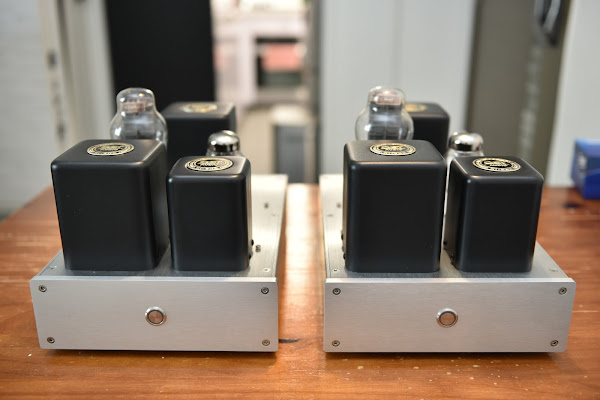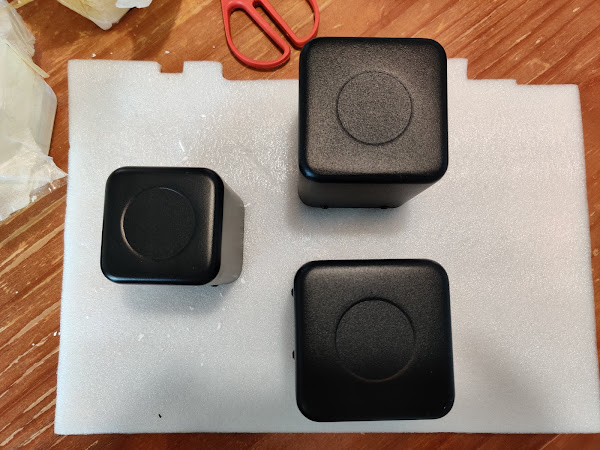DIY 300B Monoblock
I have been working on several EL84 tube amps - stereo, dual mono and mono. All of them sound great, but the problem is that each channel can only output 1.4W max, which is good enough for close listening in a small space. As for the next project, I decided to build a pair of monoblocks which can output larger power.
Why monoblocks? Because monoblocks can deliver the clearest sounds without affecting the other channel (crosstalk). And it's relatively easier to build a pair of monoblock VS a dual mono.
So now it comes to the selection of tubes. I like listening to vocals, people are saying both 2A3 and 300B are very suitable for vocal and both tubes are quite similar. However 300B can deliver larger power, so I decided to go for 300B.
Design Rationale
I like simple and clean things, and cannot withstand wires flying from one end to another like a spider web, so I decided the tube amps as simple and clean as possible. There is no volume control or input selection, these should be done by pre-amps (which I do not have). As you may be aware in the previous blogs, I only have Raspberry Pi streamer which working as a DAC and a pre-amp. Personally I do not think a pre-amp, which functions primarily as a singal amplifier, is required in modern equipment. Of course you will still need a pre-pre-amp, or a pre-amp, for your turnable.
Specification
-High voltage regulated by LM317.
-300B heater is DC powered by LM1084
-Each channel delivers about 5W
Hand Wiring VS PCB
Some people claim that tube amps made of hand wiring (point to point wiring) sound better. However I cannot agree that. The first tube amp I made was P2P wiring, but I could not tell the difference if the tube amp was re-made using the same schematic and component. The only advantage is that retailer can sell the product for a higher price.
There are several advantages using PCB over handwire:1. Planning - I would spend 95% of the time working on planning, and spend 5% of the time on soldering. This would help to reduce risk by thoroughly thinking where and how to place components beforehand instead doing both planning and soldering at the same time.
2. Saving Space - Handwiring wastes lots of space placing components, so usually the case of hand-wired tube amps are huge. That would not be a problem for anyone who live outside HK. But as long as you have been to HK, or you live(d) in HK, you would know space is a luxury.
3. Complexity - I have never seen a hand-wired tube amp has voltage regulation WITHOUT using a PCB. Tube amps with DC powered heaters usually utlize LPS modules which contains PCB. Not to mention the high voltage regulation in this pair of monoblocks.
4. Noise immunity - Hand-wired tube amps usually have a ground copper bar which is 1D. But for double sided PCB, both sides can be poured with copper planes which help to reduce noise significantly.
5. Others - There are other advantages of using PCB worth mentioning, such as better insulation and reproductivity.
Below pictures show how the monoblocks were built:
Below shows the measurement result of the monoblocks. The high voltage was intentionally set to "not so high" level in order to prolong a life of tubes and produce a warmer sound. Thanks to the regulated voltages and precise 1% metal film resistors the acutal measured values were very similar to the target values. Please note that since 300B heat is DC powered, it is normal to have 3V lower than the set voltage.
Resources
For those who are interested in building the 300B monoblocks, please refer to the below links for the schematic and gerber. It is free to circulate.
Schematic:
https://drive.google.com/file/d/1OifPyWMN51zQhfMb4BclZsQ0twg3Vjyj/view?usp=sharing
Gerber:
https://drive.google.com/file/d/1KOmB9aYcTYTz5qyHZd0in6v7ZXbp7Edn/view?usp=sharing
Final Words
300B can actually withstand a higher voltage, however now anode voltage is only set to 300V. This aims to prolong the life of 300B since it is expensive nowsdays. There are possible improvements for this project in the future, such as delayed soft start of heater and high voltage, and heat dissipation thru the case instead of heat sink, etc. Probably I will have this version updated in the near future.





















Hi - these look great! Do you have a BOM available?
ReplyDeleteI was so excited as I have 300b's and 6sn7's along with output transformers, the PCB looks great but the links are dead for drive.
ReplyDeleteNot sure what has happened to the links. Can you try these instead?
DeleteSchematic:
https://drive.google.com/file/d/1c9HOARit7xmkLAGDylH6Ss2q0qjCgovr/view?usp=sharing
Gerber:
https://drive.google.com/file/d/1zZzD_Alhnd0quR_zWVRytoF4OK6Y6d6n/view?usp=sharing
By the way, a new version of 300B monoblocks are made in 2023 with some added features, for more details please visit:
Deletehttps://www.facebook.com/SMPGadgets
Thank you for the fast reply! My pile of parts also thanks you:)
Delete